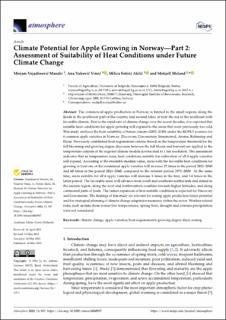| dc.contributor.author | Mandić, Mirjam Vujadinović | |
| dc.contributor.author | Vimić, Ana Vuković | |
| dc.contributor.author | Akšić, Milica Fotirić | |
| dc.contributor.author | Meland, Mekjell | |
| dc.date.accessioned | 2024-01-11T13:09:33Z | |
| dc.date.available | 2024-01-11T13:09:33Z | |
| dc.date.created | 2023-08-31T10:27:01Z | |
| dc.date.issued | 2023-05-26 | |
| dc.identifier.citation | Vujadinović Mandić, M., Vuković Vimić, A., Fotirić Akšić, M., & Meland, M. (2023). Climate Potential for Apple Growing in Norway—Part 2: Assessment of Suitability of Heat Conditions under Future Climate Change. Atmosphere, 14(6), 937. | en_US |
| dc.identifier.issn | 2073-4433 | |
| dc.identifier.uri | https://hdl.handle.net/11250/3111134 | |
| dc.description.abstract | The commercial apple production in Norway is limited to the small regions along the fjords in the southwest part of the country and around lakes or near the sea in the southeast with favorable climate. Due to the rapid rate of climate change over the recent decades, it is expected that suitable heat conditions for apple growing will expand to the areas that were previously too cold. This study analyses the heat suitability of future climate (2021–2100) under the RCP8.5 scenario for 6 common apple varieties in Norway: Discovery, Gravenstein, Summerred, Aroma, Rubinstep and Elstar. Previously established heat requirement criteria (based on the temperature threshold for the full blooming and growing degree days sum between the full bloom and harvest) are applied to the temperature outputs of the regional climate models downscaled to 1 km resolution. The assessment indicates that as temperature rises, heat conditions suitable for cultivation of all 6 apple varieties will expand. According to the ensemble median value, areas with the favorable heat conditions for growing at least one of the considered apple varieties will increase 25 times in the period 2021–2040 and 60 times in the period 2041–2060, compared to the referent period 1971–2000. At the same time, areas suitable for all 6 apple varieties will increase 3 times in the first, and 3.8 times in the latter period. The favorable areas will advance from south and southeast northwards and inland in the eastern region, along the west and northwestern coastline towards higher latitudes, and along continental parts of fjords. The fastest expansion of heat suitable conditions is expected for Discovery and Gravenstein. The findings of this study are relevant for zoning apple production future potential and for strategical planning of climate change adaptation measures within the sector. Weather-related risks, such as risks from winter low temperatures, spring frost, drought and extreme precipitation were not considered. | en_US |
| dc.language.iso | eng | en_US |
| dc.publisher | MDPI | en_US |
| dc.rights | Navngivelse 4.0 Internasjonal | * |
| dc.rights.uri | http://creativecommons.org/licenses/by/4.0/deed.no | * |
| dc.title | Climate Potential for Apple Growing in Norway—Part 2: Assessment of Suitability of Heat Conditions under Future Climate Change | en_US |
| dc.type | Peer reviewed | en_US |
| dc.type | Journal article | en_US |
| dc.description.version | publishedVersion | en_US |
| dc.rights.holder | © 2023 by the authors | en_US |
| dc.source.volume | 14 | en_US |
| dc.source.journal | Atmosphere | en_US |
| dc.source.issue | 6 | en_US |
| dc.identifier.doi | 10.3390/atmos14060937 | |
| dc.identifier.cristin | 2171285 | |
| dc.relation.project | Landbruksdirektoratet: 2020/72550 | en_US |
| dc.source.articlenumber | 937 | en_US |
| cristin.ispublished | true | |
| cristin.fulltext | original | |
| cristin.qualitycode | 1 | |

